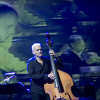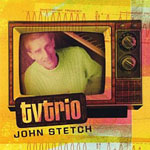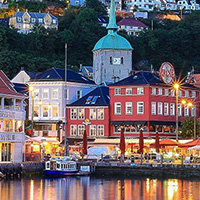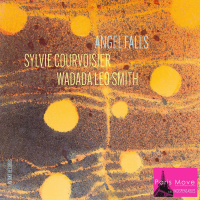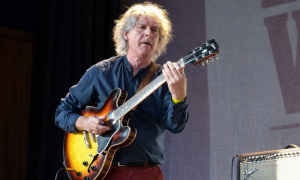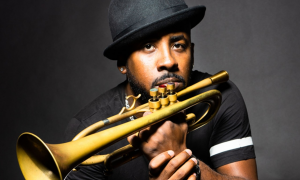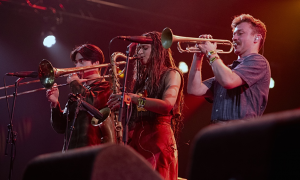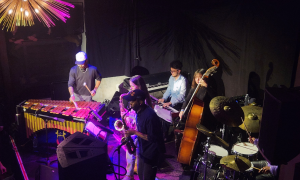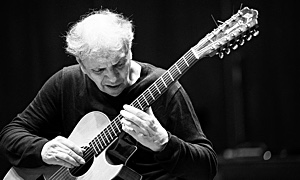Home » Jazz Articles » Live Review » Punkt Festival 2009: Day 4, Kristiansand, Norway, Septem...
Punkt Festival 2009: Day 4, Kristiansand, Norway, September 5, 2009
For its fifth year, Punkt Festival's evening programming was, more than any other, organized around clearer thematic lines, although that still meant a considerably broader purview than most other festivals—and, of course, there was the occasional exception. The first day spotlighted up-and-coming talent; the second, largely more experimental improvisation; and the third, singer/songwriters. For Punkt 2009's final day, the emphasis was more decidedly on jazz, in conventional terms, than on any other. Still, within that very broad spectrum, the music ranged from a conventional piano trio format playing anything but traditional jazz; an improvising duo that has, for this performance, expanded to a quartet for a more chamber jazz approach; and an artist for whom his latest project doesn't just stretch the boundaries of jazz but dissolves them and, in so doing, creates an entirely new language.
The final day of Punkt usually involves a trip for its guests—artists, media, labels, publicists— that often means a chance to get out on the water for a chance to explore the marvelous scenery around Kristiansand, located at the southernmost tip of Norway. With the weather forecast less than cooperative, and with some special Punkt Seminar programming planned for the early afternoon, the activity this year may have been shorter and not involving water (other than some drizzle that continued to fall during the morning, but finally made way for sunshine in the afternoon), but it was no less thoughtful—an opportunity to hear Susanna & The Magical Orchestra unplugged, performing a brief concert at the 200 year-old Gimle Gård Manor House Museum.
The last day also delivered a couple of surprises for Punkt fans—one, for Punkt artists as well— that truly defined the multifaceted, multidisciplinary and always forward-thinking premise that if a concept is becoming too safe, too predictable, then the Punkt way is to shake it up and look for ways to get it out of its comfort zone. One of Punkt's biggest advocates in the media has been Fiona Talkington of the British Broadcasting Corporation (BBC), who has not only been at the festival since its inception, but was instrumental in bringing it to London in 2008, for the festival's first road trip (the first, now, of many planned). With Live Remix one of the core premises of the festival, it's a moveable feast that only needs a venue with two rooms that can be connected technologically.
Talkington was recruited to be the festival's presenter for its fifth anniversary, and they couldn't have picked a more articulate spokesperson. Every introduction not only described the act to come, it contextualized it within the broader purview of the festival. Talkington also took the opportunity, twice during the festival, to conduct brief public interviews with its founding co-artistic directors, Jan Bang and Erik Honoré to shed some light on what they felt was the purpose of Live Remix. Bang described it as working simultaneously in the past, present and future, while Honoré explained that the festival's inception was founded, at least in one part, on a wish to take the concept of remix—originally an innovation but, by the turn of the century, something that had become corporatized and commoditized—back into experimental territory by removing the comfort zone of time. In the studio, he explained, producers sometimes have months to meticulously make their choices and shape their remixes; at Punkt, they usually have only minutes— something that can be both exciting and frightening at the same time.
As Punkt 2009 wound its way to the finish line, there was little doubt that nothing about it could be considered safe; and that with a remarkable new first—a remix of a remix—even its own innovations could be subject to the same desire to avoid predictability and caution on which it was initially founded.
Chapter Index
- Susanna & The Magical Orchestra
- Arve Henriksen "Cartography"
- Live Remix: Peter Tornqvist/Members of the Kristiansand Symphony Orchestra
- Helge Lien Trio
- Bugge Wesseltoft/akiko
- Albatrosh, featuring Lene Grenager/Hild Sofie Tafjord
- Live Remix: Helge Sten/Jan Bang
- Punkt Kunst: "Exits"
- Festival Wrap-Up
Susanna & The Magical Orchestra
One of the biggest opportunities of attending Punkt is the chance to participate in one-time events, performances that will rarely, if ever, be heard again. And so, when a small group (under 20) of festival guests were driven up to Gimle Gård Manor House Museum for a short acoustic set by Susanna & The Magical Orchestra, following its Agder Theatre performance on Day Three, it was an even rarer privilege. Singer Susanna Wallumrø and keyboardist Morten Qvenild may well occasionally perform in an acoustic context—other than one electric keyboard used very sparingly and fed through the smallest of speakers, this was a completely unplugged performance, without microphones or PA system—but likely never in such beautiful surroundings as the museum.
Gimle Gård Manor House Museum, built towards the end of the 18th century, was a private home/mansion until the mid-1980s, when the family that owned it passed on and it was converted into a public museum. In a room lined with gorgeous artwork, it was an ideal context for Susanna & The Magical Orchestra's intimate performance—a five-song set that, rather than focusing on the duo's just released 3 (Rune Grammofon, 2009), culled most of its material from the all-covers Melody Mountain (Rune Grammofon, 2006) (with the exception of 3's rework of Roy Harper's melancholy "Another Day").
The duo performed an elegantly spacious version of Bob Dylan's "Don't Think Twice, It's Alright," a take on "Jolene" that was likely far darker than what Dolly Parton ever had in mind, and a completely stripped-down reworking of Joy Division's "Love Will Tear Us Apart," contrasting with the duo's equally brooding but more texturally rich version from the night before. All too often, when a group is taken away from PA systems which allow the quietest moments to be clearly heard, and the benefits of live mixing, reverb and, in the case of Susanna & The Magical Orchestra, additional processing to expand the aural landscape, what's left are glaring deficiencies. Quite the opposite, Wallumrø's voice was even more commanding, bringing clarity to the quietest whisper. None of her nuances were lost and, if anything, her delivery was even more vulnerable and heart-breaking. Qvenild's playing was equally spare, even more empathically linked with Wallumrø than in the larger context of regular performances.
The high point of the brief set was Leonard Cohen's enduring "Hallelujah," even surpassing the duo's version on Melody Mountain. With a tremendous vocal range and potential for greater melisma, it would be far too easy for Wallumrø to fall into the trap of other Cohen interpreters who put their voices ahead of the words. Instead, it's Wallumrø and Qvenild's very talent that liberates them to fill every decaying note, every fragile phrase with profound meaning—not just on "Hallelujah," but in every song of this very special—and all-too-brief—performance.
Arve Henriksen "Cartography"
Arve Henriksen's Cartography (ECM, 2008) is more than a career consolidation and the trumpeter's most impressive musical statement to date; it's truly a new way to look at the process of composition, a new approach to collaboration and improvisation, and a more production-intensive project that's at odds with ECM's usual two day recording, one day mixing philosophy. But with the album now a year old—and its creation dating back even further—in performance it has continued to evolve, even as Henriksen performed it as a trio with live sampler Jan Bang and guitarist Eivind Aarset at Natt Jazz 2009 in Bergen, and expanded to a quartet with percussionist Helge Andreas Norbakken at Molde Jazz 2009. Henriksen's Punkt performance augmented the core trio with Trio Mediæval soprano Anna Maria Freeman, who also participated in Henriksen's stunningly moving closing performance to his run as Artist-in-Residence at Molde Jazz.
If the opportunity to watch Henriksen perform this music three times in one year has shown anything, it's that Cartography is more than an album; it's a new language that the trumpeter continues to hone, in concert with his band mates. Many of the same pieces were performed, notably the powerfully moving "Recording Angel," which opened the hour-long set. But while some of the key definers remain constant—most notably Henriksen's deep lyricism and, even in the rare moments where the freer improvisations turned more angular, a profound bond with his audience—the way in which he interacts with Aarset and Bang continues to evolve to a level so mitochondrial that it's no surprise that, amongst the many visuals that turned the show into an experience for the eyes as well as the ears, there was text describing the nature of DNA and the human genome.
Friman's participation added a new dimension to the music, her pure voice providing a melodic counterpoint to Henriksen's horn—and his own angelic falsetto. At times singing together, it was a hint of the music the two performed together at the Molde closing concert, but the benefit of a smaller ensemble meant more room for extemporaneous exploration. When she first appeared, she was using the same hand-held tuned percussion (long, rectangular bars that, when shaken, created single, vibraphone-like notes) as she did with Trio Mediæval; Henriksen, too, used these unusual instruments. Aarset and Bang—now going back many years together as members of trumpeter Nils Petter Molvaer's now-dissolved quintet—are both sonic conceptualists who are constantly finding new ways to evolve the music of Cartography. Aarset, in particular, eschews traditional virtuosity (though he is, undeniably, one) and here, like so many of the musicians performing at Punkt, was about serving the demands of the music, not himself.
Henriksen's palette continues to broaden and refine. In addition to expanding extended techniques for his three horns, singing is becoming a larger part of what he does. In addition to his vulnerable falsetto, he demonstrated increasing skill at throat singing, creating brief, sometimes rapidly delivered monologues in Norwegian that, with references to Friman and Punkt, were still partially clear to the festival's English-speaking contingent, and singing in his natural range with increasing power. The music was texturally rich and, linking a number of pieces together into two continuous suites, remarkable for its ability to mesh free improvisation with constructed segments that were all the more remarkable for their sudden emergence through cues that were barely, if at all, perceptible. As Cartography continues to evolve, it's chances to hear it in performance that provide the best window into where Henriksen is going with this new and distinctive vernacular.
Live Remix: Peter Tornqvist/Members of the Kristiansand Symphony Orchestra
Another of Punkt's regular participants is Kristiansand Symphony Orchestra's Peter Tornqvist. While not precisely a live remix, the conductor/composer took aspects of Henriksen's Cartography, using them as the foundation for a contemporary composition that still incorporated both free improvisation and live sampling, to demonstrate that even in the classical world, new technological innovation is being used to keep the music alive and relevant.
With a 14-piece ensemble that included strings, woodwinds, horns and percussion, in addition to violin soloist Victoria Johnson (currently a research fellow at The Norwegian State Academy of Music), an electric keyboard and that ubiquitous Punkt staple, the MacBook, Tornqvist's group took up almost the entire floor in the Alpha Room. In many ways, Tornqvist's composition seemed, at least on the surface, a direct contrast to what Henriksen is about. The trumpeter's melodicism was replaced by more oblique themes; a smoother improvisational veneer was replaced with sharper, more angular and often more jarring soloing; and music of layered complexity was replaced with writing that was both longer in form and more detailed in construction. It made for a less-than-obvious link between the two, and yet there were connections to be found, most notably in the interaction between the ensemble's primary soloist—who scraped and scratched the strings as much as she bowed them in more traditional fashion—and Tornqvist's live sampling of her often extreme approach.
A link could also be found conceptually, as Tornqvist continues the search for ways to expand the classical language. Long, droning string passages worked in concert with tuned percussion to create an ever-shifting foundation. And while the link was less direct, what Tornvist achieved as an extension of Henriksen was something more aesthetic. A remix, at its core, is about taking one person's music, deconstructing it and rebuilding it with the voice of the remixer, moving both artists' music forward in new and unexpected ways. Inspired by Henriksen's language—and, from past years' performances at Punkt, that of other modern improvisers—Tornqvist has been creating his own expanding musical philosophy; one that lives unmistakably in the classical world but, at the same time, breaks down its own borders by bringing in elements anathema to purists. If the only way for music to move forward is to intrepidly take risks and look past conventions, then Tornqvist is a hidden treasure in Kristansand; an artist ignoring the confines of his chosen field and, instead, searching for new ways to make it relevant in the new millennium.
Helge Lien Trio
A recent winner of the Norwegian Grammy for Hello Troll (Ozella, 2008), pianist Helge Lien and his trio, featuring bassist Frode Berg and drummer Knut Aaleflæt, made his first appearance at Punkt. Possessing many of the qualities that made Hello Troll such an impressive release, it was also an opportunity to hear the trio take considerably greater liberties with the music.
It is, perhaps, a little too easy to compare Hello Troll with the music of the late Esbjorn Svensson and his trio, e.s.t.: strong grooves, accessible European classicism married with a certain pop-like sensibility, and unmistakable virtuosity rooted in the music of Keith Jarrett, Bobo Stenson and Jan Johansson. But in performance, Lien's music takes on considerably greater risk. Expanding Hello Troll's "Axis of Free Will" into a lengthy rubato exploration before finding its way to the driving piano motifs that define it, Lien's breadth of range—from delicate touch and nuanced economy to greater power and virtuosity—was immediately evident. It was, in fact, a particularly strong window into the workings of a group that may work in the tried-and-true conventional format of the piano trio (and there's no mistaking its roots in the jazz tradition), but here, and on the even more impressionistic "Radio," the trio demonstrated a flexibility and telepathy that, with six albums under its belt since 2000, continues to get deeper with each passing year.
Hello Troll may be more eminently accessible, and songs like the Latin-esque "Troozee" still grooved along with gentle forward motion, but the group dynamics were even stronger in performance, with Aaleflæt especially in touch with Lien, but the entire trio managing to create unexpected shifts at the drop of a hat. With an expanded drum kit that included bongos, bell trees and chimes, Aaleflæt didn't get any solo space per se (even Berg only got one), but his fluid elasticity and intuitive responsiveness were unmistakable components of the trio's collective voice. Berg's arco was as warm as his pizzicato, and it was part of the trio's personal approach to arrangement that found him bowing the anticipated line at the foundation of "Troozee" rather than plucking it (though he did eventually switch).
As for Lien, he's a thrilling player capable of creating lengthy, cascading motifs and sophisticated, pulse-driven voicings, but never for their own sake. "It Is What It Is, But It Is" may be an elliptical title, but it was an evocatively appealing piece with Jarrett-like gospel tinges, one of the set's more direct pieces that also include a solo from Berg that was at the nexus point between Arild Andersen and Anders Jormin. It provided a soft contrast to "Halla Troll," which came closest to approximating e.s.t.'s weighty propensities though, without that trio's bassist Dan Berglund and his heavily processed double-bass, remained more organic, even as it went to free spaces that Svensson's trio never did, even with its marvelous and sadly final album, Leucocyte (ACT, 2008).
Lien's trio also won the 2008 Kongsberg Jazz Festival's DnBNor Musicians Award, and with albums like Hello Troll and shows like its Punkt debut, it's a trio well deserving of broader international exposure.
Bugge Wesseltoft/akiko
Another member of the extended Punkt family, keyboardist/producer Bugge Wesseltoft demonstrated another aspect of the festival: trust. Having just finished recording akiko's new album in Oslo, the Jazzland label head brought the diminutive Japanese singer to Punkt without the festival having heard a single note. Wesseltoft's endorsement was all the festival needed, and their brief set—the only Alpha Room performance that wasn't a remix—was proof that their faith in the pianist's instincts was merited.
Wesseltoft opened the set with the title track to his most recent release, Playing (Jazzland, 2009), using an upright piano, a single electric keyboard, a mixer and a foot pedal that allowed him to apply reverb-drenched, Harold Budd-like ambience at will. Concentrating less on group projects and more on solo performance in recent years, Wesseltoft has been honing a hybridized approach to electro-acoustic playing that continues to reference certain aspects of jazz harmony, while being equally influenced by Norwegian traditionalism and romantic classicism. His music, even at its darkest, possesses a certain optimism that reflects his own personality. With easier access to the strings of his upright piano, it was possible for the pianist to integrate extended and prepared techniques.
As Wesseltoft began to play the second piece, akiko quietly walked onto the floor and began to sing in a near-whisper. With an almost naïve, child-like melody, she created an instant connection with the audience, one that was cemented when, after the song was over, she humbly introduced herself. Her approach combined spoken word and melody, with ambiguous lyrics that touched on matters of love, life and existence. Wesseloft's accompaniment ranged from spare, feather-light and acoustic (with the occasional injection of reverb to broaden the soundscape) to creating deep, in-the-gut bass synth sounds. Sampling her voice, he created occasional background washes from that further enhanced the landscape, also resorting to a more low-tech sound enhancement when he took a sheet of paper and slipped it between the strings and hammers of his piano.
The short set was a compelling introduction to a singer from whom more will be heard, and very soon.
Albatrosh, featuring Lene Grenager/Hild Sofie Tafjord
A lot can happen in a year. When Albatrosh—the duo of pianist Eolf Dale and saxophonist Andre Roligheten, two young music students—performed a short set for the members of the 2008 JazzNorway in a Nutshell participants, in the small village of Rosendal, on the way to Stavanger, it was early days. Still unrecorded, the duo demonstrated a remarkable improvisational and compositional sophistication, one which would be rewarded a few short months later, at the 2008 Molde Jazz Festival, where they won the prestigious Jazz Intro prize. The pair went into the studio soon after, and recorded their critically praised debut, Seagull Island (Inner Ear, 2009).
Sixteen months after Rosendal, Albatrosh made its debut at Punkt with an expanded line-up that also included French hornist Hild Sofie Tafjord and cellist Lene Grenager—two members of the all-improv group Spunk (which also included singer Maja Ratkje, who performed on Day Two), which recently released Kantarell (Rune Grammofon, 2009). The growth in Dale and Roligheten's playing was palpable, but even more so was their writing, which continues to leave copious space for the free exchange of ideas but, in addition, demonstrates a remarkable leap in sophistication for these two young players who are currently studying for their Master's degrees in music.
Splitting the writing between Dale and Roligheten, and between compositions from Seagull Island and newer work, the quartet provided a number of opportunities. Dale and Roligheten, who have been playing together for a number of years despite their young ages, continued to mix greater extremes—especially Roligheten, who's gradually emerging voice has at least some precedence in the playing of John Zorn and fellow Norwegian, Hakon Kornstad and uses similar approaches to percussion, multiphonics and overtones—with more abstract ideation and, at times, passages of great beauty. Tafjord and Grenager, in the context of Spunk, are fearless improvisers, and they brought a similarly unfettered approach to their work here; but equally, it was a treat to hear them working with more through-composed material, creating an unusual ensemble sound with a less-than-orthodox combination of saxophone or bass clarinet (the latter, a new addition for Roligheten), French horn and cello.
Roligheten's tendency, as a writer, is towards creating cued and oftentimes knotty motifs that act as rallying points for collective improvisation, while Dale's lean towards more complex form. In both cases, there's greater depth and, with this unique chamber setting, a chance to explore greater textural diversity. While Roligheten's quirky themes are often clear, the line between form and freedom became, at least some of the time, more blurred for Dale. The saxophonist's breadth and improvisational acumen was stronger than ever, while Dale continued to demonstrate a sometimes cartoon-like approach to accompaniment, with relentless, walking bass lines peppered with right hand chords. Tafjord and Grenager took a break during Roligheten's "Matrosh," where the pianist and saxophonist demonstrated, in even clearer terms, just how much their collective personality has grown.
That a pair of musicians, just into their twenties, can write and play with this degree of maturity and sophistication is an ongoing endorsement of the value of arts education from an early age. With this much growth in only a year, it's hard to imagine where Albatrosh will be 12 months from now.
Live Remix: Helge Sten/Jan Bang
The final live remix at Punkt is almost always a memorable one. Two years ago, trumpeter and one of Punkt's founding fathers, Jon Hassell, delivered a final remix that remains one of the festival's most moving. For the closing remix of Punkt 2009, Jan Bang and Supersilent guitarist/sonic revolutionary Helge Sten broke new ground with a Punkt first: a remix of a remix. Sitting in the audience during Peter Tornqvist's remix of Arve Henriksen's "Cartography" performance with a couple of Dictaphones, the two decided to tackle the challenge of taking Henriksen's evolving language one step further by reshaping the first remix and bringing its largely acoustic nature back into the realm of electronics and sound sculpting.
There was, in fact, another link between this remix and Hassell's from 2007. While remixes have no advance planning in terms of specific content, the line-ups are usually determined well in advance. Hassell chose, instead, to attend Punkt 2007 in its entirety, choosing his collaborators relatively at the last minute on the final day. Similarly, Sten's remix for this year was billed as "Helge Sten + guests," allowing him the flexibility to recruit who he wanted as near to the remix as possible. That he ultimately chose to work only with Bang was interesting; as a member of Henriken's group, Bang was in the perfect position to both bring some of the language back full-circle while, forward-thinking improviser that he is, working with Sten to drive "Cartography" in a new direction.
Like Eivind Aarset, Sten's approach to guitar is often significantly removed from convention. As the remix began, with Bang taking the music back to the softer ambience of its source, Sten's heavily effected instrument sounded more like something that would be heard in a gamelan ensemble, albeit one slowed down and dropped in pitch well below the range of the normal tuned percussion used. The overall ambience was darker than Henriksen's as well, no surprise given Sten's production alter-ego moniker, Deathprod. Still, despite the more brooding and occasionally dense sonics, there were moments of stunning beauty, especially near the end of the remix when Sten began playing a simple and ethereal series of chords.
It's difficult to begin a remix, coming as it usually does, from almost nothing and the demand of choosing from near-infinite possibilities; equally challenging is determining when to end. Twice during the remix, the music began fading to near-silence but then, in each case, it became clear that there was something more to explore, with Bang in one case and Sten in the other, emerging from the space to begin building new ideas, upon which the other then latched. It was a perfect example of the give-and-take that makes each and every Live Remix both a challenge and an opportunity.
Punkt Kunst: "Exits"
Another of Punkt's friends is poet Nils Chr. Moe-Repstad, a Kristiansand local who as part of another of Punkt 2007's better remixes, where he and Erik Honoré provided their own look at Trio Mediæval's performance. For the closing concert of Punkt 2009, Moe-Repstad's subject matter was not as bleak as his 2007 poem surrounding World War II atrocities. Still, it was filled with dark images and meditations on the meaning of existence.
Deep subject matter, indeed, for a closing multimedia concert that consisted of new music by Bang and Honoré, commissioned visuals by Russell Mills, set designs by Tord Knutsen, and the participation of many of this year's participants, including Bugge Wesseltoft, Arve Henriksen, Anna Maria Friman, Eivind Aarset, Adam Rudolph, Guy Sigsworth, Tim Motzer and BJ Cole. With a collection of such powerful musical voices, what was most impressive about the performance was its reliant on silence, its avoidance of ego that would demand a feature spot for everyone involved, and an overall concept that was more about shaping a modern composition and finding the best way to support Moe-Repstad's understated but commanding delivery. Punt Kunst has always been about bringing disciplines together to create something greater than the sum of its parts, and while every component of "Exits" was compelling individually, not a single one would have carried as much weight as it did here.
With Bang and Honoré creating a broader context, "Exits" also possessed plenty of spontaneity, even though there was clear direction driving it. Friman received, perhaps, the single greatest feature, though that may have been largely due to a voice that soared above everything else around it. Henriksen and Bang, too, got a brief passage, with Bang sampling a Henriksen-sung melody with great intervals between the notes, and feeding it back to create a subtle choir that was absolutely the result of their work together in the trumpeter's group. From the midst of a soft percussion pulse from Rudolph, BJ Cole's pedal steel emerged briefly, referencing his work with Harold Budd, while Wesseloft had brief solo piano spot early on.
But ultimately it was Moe-Repstad's words and delivery that were the focal point of "Exits." With an English translation of his Norwegian poetry projected on the backdrop as he spoke them, the most powerful moments were those where he dropped to barely more than a whisper, repeating the same phrase. Power needn't be measured in terms of volume or drama; sometimes the most potent statement is the one that demands its audience lean forward intently. When Moe-Repstad repeated the final phrase, "And a God still makes the waves," it was one of many deeply profound moments:
"a sinking wreath,
the sacrifice of a believer: "Throw me into the sea,
this storm is all my fault."
And a God stills the waves."
With the music fading to nothing, it was Moe-Repstad's final stanza that lingered:
"We abandon nothing that is more than everything,
nothing that is less.
What remains is a promise of silence,
to the happy, and those with no direction."
Festival Wrap-Up
As Punkt 2009 drew to a close, friends who came together from places far and wide said their goodbyes for another year. Punkt's fifth anniversary was another year of achievement for a growing family of artists and fans, all committed to pushing the envelope of modern music. While the flagship festival in Kristiansand will remain the place where future ideas are created and moulded, the fact that it's becoming an increasingly in-demand concept that other festivals are looking to recruit is proof of just how singular it is.
As Punkt travels, in the next couple of years, to Germany, Spain, the United States and, most likely, Canada, it's emerging as one of Norway's most creative exports. The beauty of Punkt is that, while any version abroad will by definition include some percentage of Norwegian artists, it will also include local performers, a sure way to expand the Punkt family even further, and to ensure that this distinctly Norwegian creation becomes something more global—and an important unifier at a time when disparity is creating far too much divisiveness in the world.
Photo Credits: John Kelman
Day 1 | Day 2 | Day 3 | Day 4
Tags
Live Reviews
Punkt
John Kelman
Norway
Bergen
Arve Henriksen
Eivind Aarset
Nils Petter Molvaer
Esbjorn Svensson
Keith Jarrett
Bobo Stenson
Jan Johansson
Arild Andersen
Anders Jormin
Bugge Wesseltoft
john zorn
Hakon Kornstad
Jon Hassell
Supersilent
PREVIOUS / NEXT
Support All About Jazz
 All About Jazz has been a pillar of jazz since 1995, championing it as an art form and, more importantly, supporting the musicians who make it. Our enduring commitment has made "AAJ" one of the most culturally important websites of its kind, read by hundreds of thousands of fans, musicians and industry figures every month.
All About Jazz has been a pillar of jazz since 1995, championing it as an art form and, more importantly, supporting the musicians who make it. Our enduring commitment has made "AAJ" one of the most culturally important websites of its kind, read by hundreds of thousands of fans, musicians and industry figures every month.


